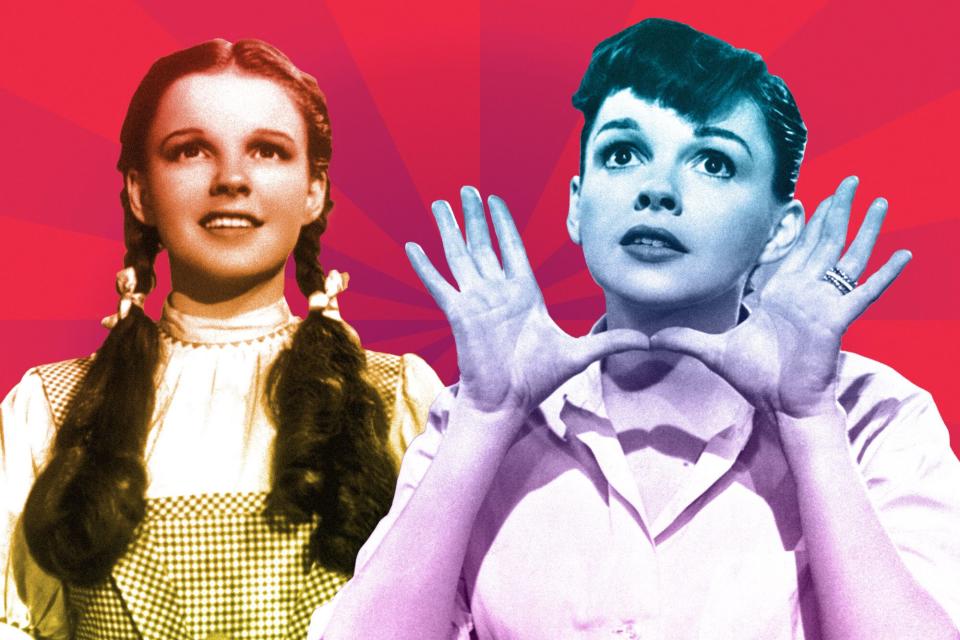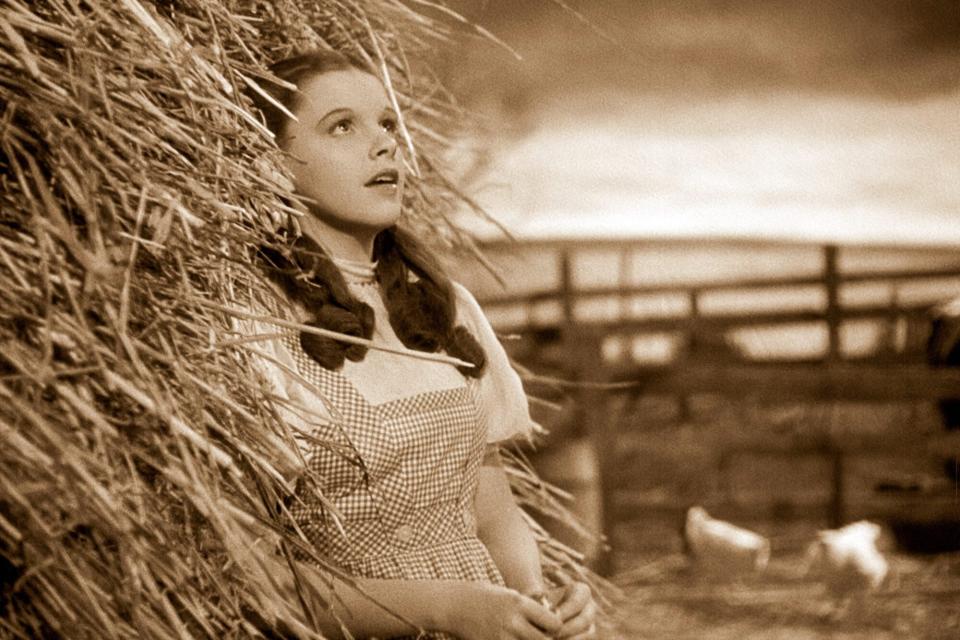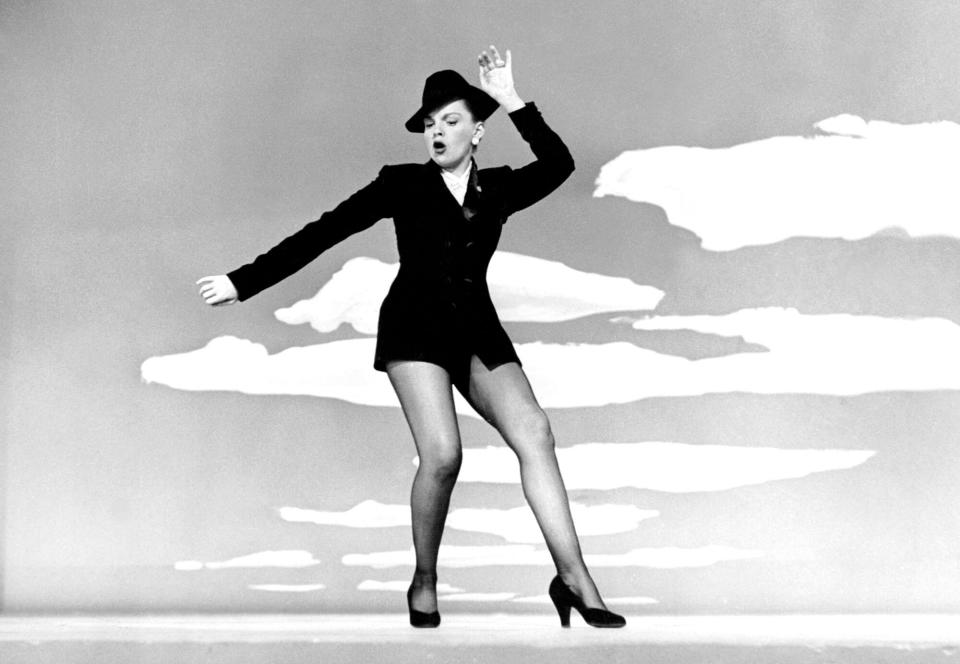How Judy Garland became a gay icon — and why she endures as one

- Oops!Something went wrong.Please try again later.
Judy Garland was an entertainer of the highest order, a deeply troubled movie star, and, even during her lifetime, a gay icon.
That last one might seem like a head-scratcher a century after her birth, when there are more out-and-proud stars to celebrate than ever. While she was alive, Garland was a figure of intense adulation among the gay community; she herself was very aware that many of her most devoted fans were queer. As early as 1967, mainstream publications were discussing the profusion of gay men in attendance at Garland's concerts and attempting to dissect her particular appeal.
The term "Friend of Dorothy," referencing her The Wizard of Oz character, became popular code among gay men to self-identify, and rumors still persist that it was Garland's 1969 funeral that sparked the epoch-defining Stonewall riots, the beginning of the modern gay-rights movement. Today, Garland remains a symbol of vulnerability, emotionality, and authenticity. Why?
Richard Dyer, who first wrote about Garland's status as a gay icon in 1986's Heavenly Bodies: Film Stars and Society, suggests that her career followed a trajectory of self-discovery, similar to those of many of her fans. "Her image was that she was very ordinary," Dyer tells EW. "And then she had all these problems that became known, and she suddenly appeared not ordinary. She was a misfit. In a way, that is the gay biography growing up. You're brought up ordinary, and then you realize that you're not."
Nathaniel Frank, an expert on LGBTQ public policy and author of Awakening: How Gays and Lesbians Brought Marriage Equality to America, pushes the point further. "She compared herself to a wind-up doll, manufactured by adults for their entertainment," he says. "So she was never able to really be herself. And yet, when she performed, she exhibited this level of authentic emotion."
"She is someone who faced great hostility, abuse, exploitation and misunderstanding in her life and found a way to be both vulnerable and resilient," Frank adds. "The appeal was much broader than Judy's queer audience, but the queer connection is a very real and persistent part of our community's history."

Everett Collection; Bettmann/Getty Images
For many fans, the first entry point into Garland is her classic portrayal of Kansas farm girl Dorothy Gale in The Wizard of Oz. While neither Frank or Dyer can pinpoint how or why the term "Friend of Dorothy" entered the gay lexicon, they both credit the beloved 1939 fantasy as playing a key role in Garland's continued resonance.
"Dorothy is inseparable from Judy — the anguished, dreaming quality, escaping from a drab black-and-white world where adults misunderstood her," says Frank. "Then this stormy day catapults her over the rainbow to a dream world where a cadre of lovable misfits like herself want to protect her. The Dorothy story of escape to a better place where people can be themselves had obvious appeal to queer people for generations."
Some have suggested that Garland's inimitable performance of "Over the Rainbow" is part of what led to the rainbow being adopted as a symbol of gay pride. But that perfect moment of movie magic (captured when Garland was just a teenager) is only the beginning: Dyer identifies Garland's later camp appeal as a key component of her staying power. In his eyes, Garland occupies a unique position as someone who is both camp and performed as camp herself.
"A lot of these gay icons are camp in the sense that she can be imitated — there's a certain kind of exaggeration in her mannerisms that's very easily imitated," he says. "But she herself had a camp sense of humor. Camp is both emotionally vulnerable and making fun of itself for being emotionally vulnerable. It's not surprising that she does camp. At MGM, she was surrounded by gay men and working closely with them, so she was very inward with that culture and it became part of her vocabulary. When you look back at the films, you see there's an awful lot of that irony and wit and humor going on, even in the '40s when it was much less overt."

Everett Collection Judy Garland in 'The Wizard of Oz'
Another complicated component of Garland's status as a gay icon was her own intimacy with gay men. Both Dyer and Frank say Garland was aware that many of her fans were gay. In her later concert performances, she made jokes about Fire Island, going "over the rainbow," and other explicitly camp nods.
"She genuinely wanted people to feel like they could be who they were," says Frank, whose grandfather, Gerold Frank, wrote 1975's Judy, one of the earliest, most definitive biographies of the star. "She wasn't as explicit about embracing gay people as stars in a later era might've been, but she was no fool. And she didn't convey homophobia or transphobia in any explicit way, either."
It's also well-catalogued that Garland had personal relationships with several gay men. Many historians believe her father was gay or bisexual, and she married at least two gay men (Vincente Minnelli, Mark Herron). "I wouldn't venture to say that Judy was fully conscious of the fact that she had close relationships with men who turned out to be gay," says Frank. "But it's also not surprising that people who have lives of emotional turmoil — in which their emotions are not given free rein — would end up in relationships with people who can't give them fully the emotional lives that they might otherwise yearn for. I hesitate to draw conclusions too explicitly about that, but certainly it's a ripe set of questions to wonder about."
And what about the most persistent legend that links Garland to the LGBTQ community — the notion that it was her funeral, on June 27, 1969, that sparked the Stonewall Riots during the early hours of the next morning? Years later, it's a story that can't be proven, nor dismissed.
"There were so many broad social forces giving momentum to the explosion of protest energy — it would have happened regardless," says Frank. "But this is how it happened, and there probably were queer people who were at the funeral who were also at Stonewall. There's a logic to drawing that connection that some of that energy spilled into the bar scene and into that historic spark of resistance and resilience."
In the end, it doesn't matter if Garland's death played a role in triggering Stonewall so much as the fact that the rumor persists at all. In Dyer's estimation, Garland's concerts were occasions for a rare breath of freedom. He recalls a letter he once received from a gay Garland fan, which described the shows as moments that "gave you permission to be gay in public for an evening."

Everett Collection Judy Garland in 'Summer Stock'
"She represented that moment of being able to be out, and suddenly, it was gone," says Dyer of Garland's 1969 death. "I don't think people rebelled because she died, but I think they were very upset and then there's a police raid, and that was just the final straw when you're already feeling wretched."
Dyer remains somewhat surprised by Garland's staying power, particularly in the face of more recent gay-resonant icons who have followed her, artists such as Kylie Minogue, Lady Gaga, and Madonna. He chalks it up to her unique place in time.
"Garland is on that cusp between the closet and openness," he explains, "and you can even say she dramatizes that. That sense of 'There's something there but it can't quite be said' is such a part of the emotions in her image and in her performances, that it is dramatizing that very moment of moving from being in the closet to being open about being gay. She's at that moment of transition, and that's why she is so particularly important."
Combined with Garland's singular talent and expressiveness, her cultural significance is here to stay, particularly to the LGBTQ community.
"Each generation looks anew at what symbols are important to them," says Frank. "And I have been heartened to see that Judy Garland makes the cut again and again."
Related content:
The 8 best Judy Garland movies to stream for her 100th birthday
Judy Garland's Oscar legacy was not redeemed by Renée Zellweger: Opinion
Meet Me in St. Louis star Margaret O'Brien on filming an iconic Christmas song with Judy Garland
Judy Garland onscreen sister Margaret O'Brien praises Renée Zellweger's take on the legend

